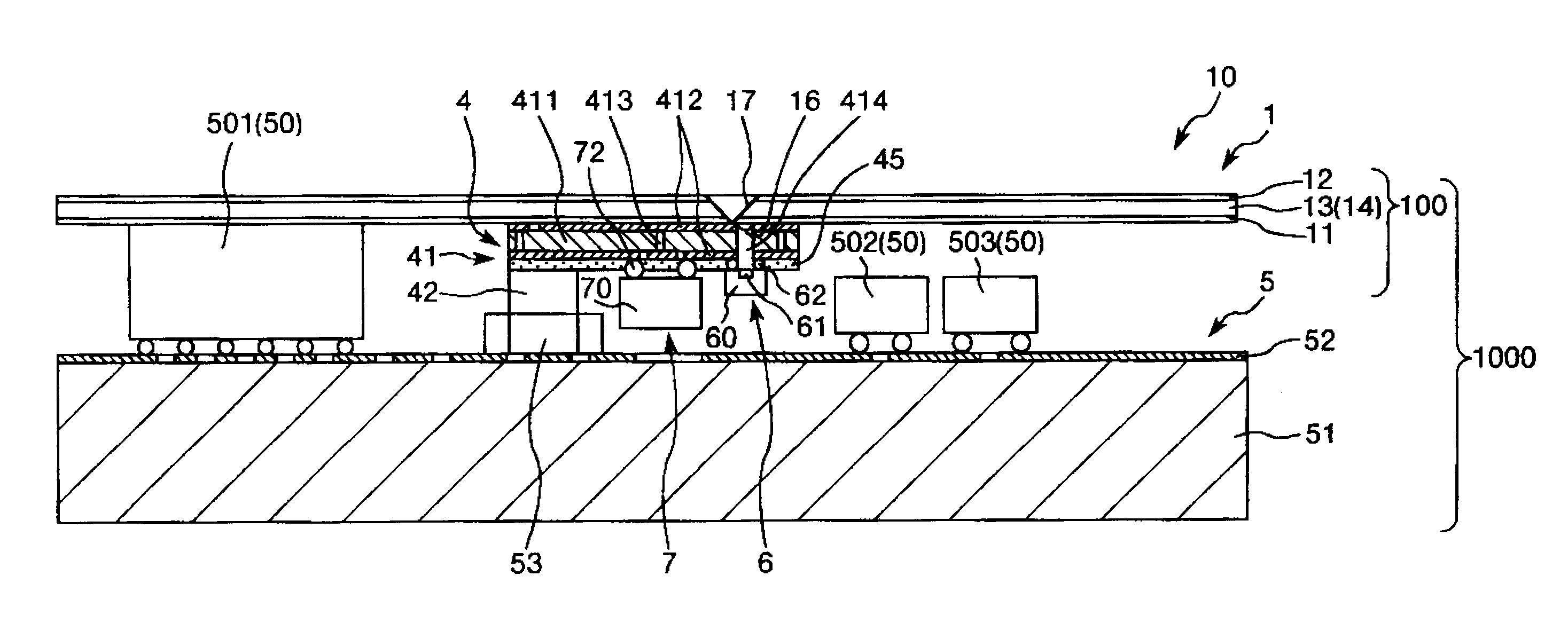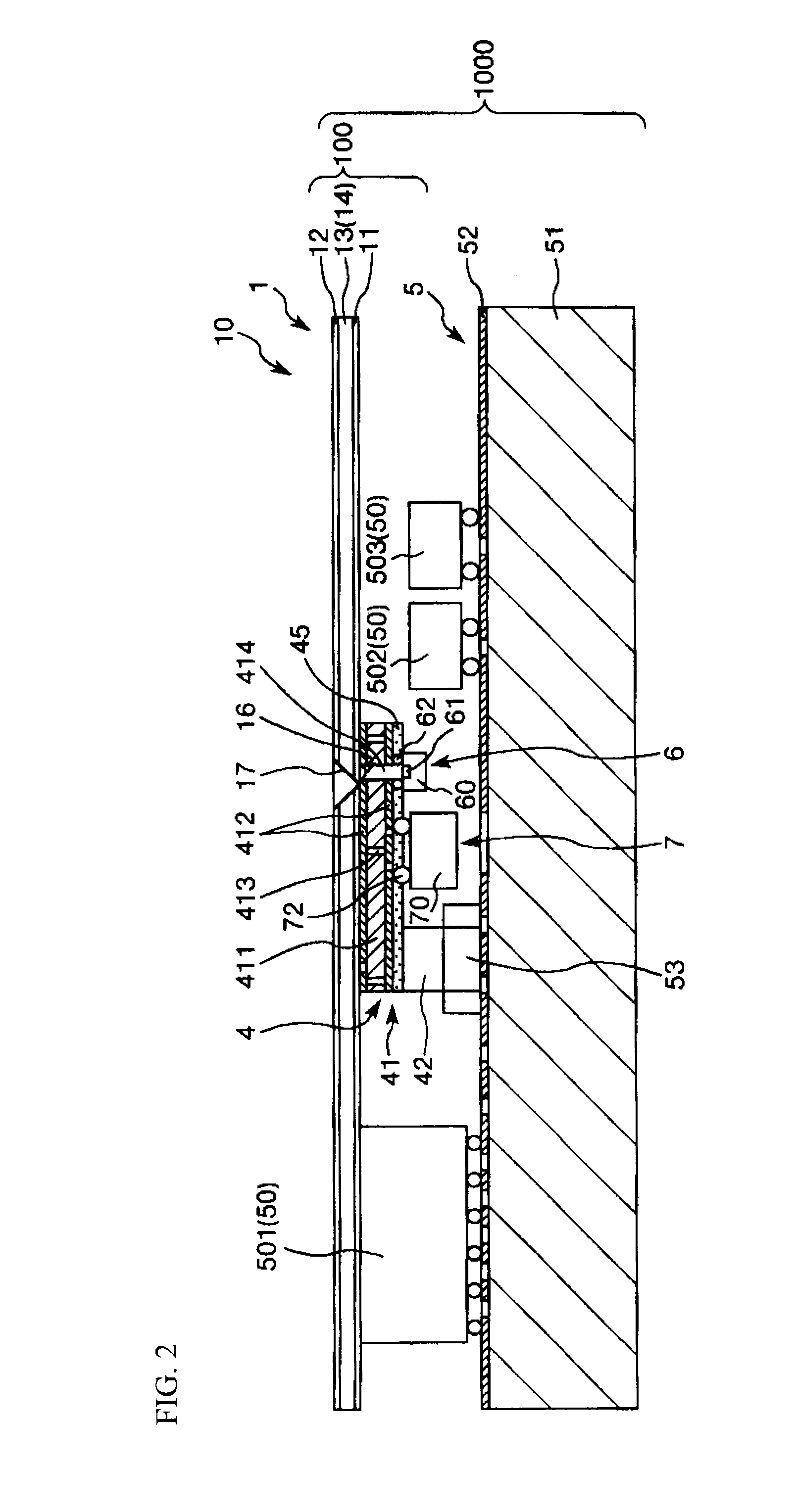Optical waveguide, optical interconnection component, optical module, opto-electric hybrid board, and electronic device
a technology of optical interconnection and optical module, applied in the direction of optical waveguide light guide, optical light guide, instrument, etc., can solve the problems of increased transmission loss, difficult coexistence of electrical elements and optical elements in planar view, etc., and achieve high density mounting of electrical wiring and optical wiring, easy assembly and repair, and high performance
- Summary
- Abstract
- Description
- Claims
- Application Information
AI Technical Summary
Benefits of technology
Problems solved by technology
Method used
Image
Examples
first embodiment
[0119]Firstly, a first embodiment of the opto-electric hybrid board of the present invention is explained.
[0120]FIG. 1 is a perspective view (shown partially cutaway and see-through) showing the first embodiment of the opto-electric hybrid board of the present invention and FIG. 2 is a line X-X cross-sectional view in the state in which the optical waveguide is superimposed as shown by the void arrow in FIG. 1.
[0121]An optical module 100 shown in FIG. 1 has an optical waveguide 1, an optical connector 101 disposed at an end section thereof, and an opto-electric conversion section 4 disposed below the optical waveguide 1. Also, an opto-electric hybrid board 1000 shown in FIG. 1 has the optical module 100, and a motherboard (electrical wiring board) 5 disposed below the opto-electric conversion section 4.
[0122]Of these, the optical waveguide 1 is a sheet-like member forming a quadrangle in the planar view. The optical waveguide 1, as shown in FIG. 2, is formed by stacking a cladding l...
second embodiment
[0273]Next, the optical module according to a second embodiment of the opto-electric hybrid board of the present invention is explained.
[0274]FIG. 13 is a cross-sectional view showing a part of the second embodiment of the opto-electric hybrid board of the present invention.
[0275]Hereinafter, although the second embodiment is explained, it is explained by placing emphasis on the points of difference with the first embodiment, and an explanation of the same matters is omitted. Also, in FIG. 13, the same constitutional parts as the first embodiment are labeled with the same reference numerals as those previously explained and a detailed explanation thereof is omitted.
[0276]Other than the constitution of the opto-electric conversion section 4 being different, the second embodiment is the same as the first embodiment.
[0277]The opto-electric conversion section 4 shown in FIG. 13 has an insulating substrate 411a disposed on the lower surface of the cladding layer 11 of the optical wavegui...
third embodiment
[0282]Next, a third embodiment of the opto-electric hybrid board of the present invention is explained.
[0283]FIG. 14 is a cross-sectional view showing a part of the third embodiment of the opto-electric hybrid board of the present invention.
[0284]Hereinafter, although the third embodiment is explained, it is explained by placing emphasis on the points of difference with the first embodiment, and an explanation of the same matters is omitted. Also, in FIG. 14, the same constitutional components as each of the above-mentioned embodiments are labeled with the same reference numerals as those previously explained and a detailed explanation thereof is omitted.
[0285]Other than having an electrical interposer (electrical wiring board) 55 interposed between the opto-electric conversion section 4 and the motherboard 5, and the LSI 501 mounted on the electrical interposer 55, the third embodiment is the same as the first embodiment. In addition, different to the first and second embodiments, ...
PUM
 Login to View More
Login to View More Abstract
Description
Claims
Application Information
 Login to View More
Login to View More - R&D
- Intellectual Property
- Life Sciences
- Materials
- Tech Scout
- Unparalleled Data Quality
- Higher Quality Content
- 60% Fewer Hallucinations
Browse by: Latest US Patents, China's latest patents, Technical Efficacy Thesaurus, Application Domain, Technology Topic, Popular Technical Reports.
© 2025 PatSnap. All rights reserved.Legal|Privacy policy|Modern Slavery Act Transparency Statement|Sitemap|About US| Contact US: help@patsnap.com



